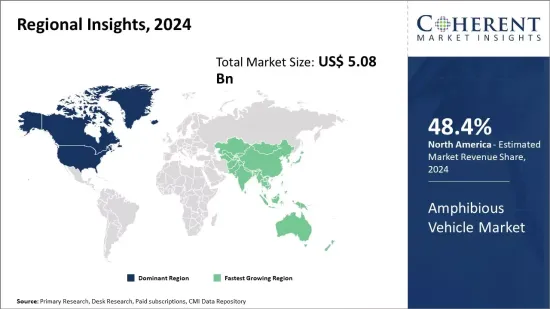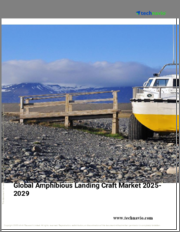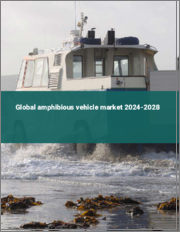
|
시장보고서
상품코드
1483154
세계의 수륙양용차 시장 : 추진 방식별, 용도별, 최종사용자별, 지역별Global Amphibious Vehicle Market, By Mode of Propulsion, By Application, By End User, By Geography |
||||||
수륙양용차 시장은 2024년 50억 8,000만 달러로 추정되며 2031년에는 105억 달러에 달할 것으로 예상되며, 2024년부터 2031년까지 연평균 10.9%의 성장률을 보일 것으로 예상됩니다.
| 보고서 범위 | 보고서 상세 | ||
|---|---|---|---|
| 기준 연도 | 2023 | 2024년 시장 규모 | 50억 8,000만 달러 |
| 실적 데이터 | 2019-2023년 | 예측 기간 | 2024-2031년 |
| 예측 기간 2024-2031년 CAGR: | 10.90% | 2031년 가치 예측 | 105억 달러 |

암트랙(수륙양용 트랙터)으로도 알려진 수륙양용차는 육상과 수중에서 모두 작동하도록 설계된 자동차입니다. 수륙 양용 차량은 육지와 수중을 모두 항해 할 수있는 독특한 능력을 가지고 있기 때문에 주로 군사, 구조, 레크리에이션 및 기타 용도에 사용됩니다. 수륙양용차는 군대가 해안에 직접 상륙하여 작전을 위해 내륙으로 이동할 수 있습니다. 비상시에는 인력과 물자를 물 장벽을 넘어 대피시킬 수도 있습니다. 그러나 수륙양용차는 기계적으로 복잡하고 제조 비용이 높습니다. 수륙양용차의 엔진과 변속기는 수중 환경에서 지속적으로 작동하기 위해 물의 침투를 방지하는 밀봉과 차폐가 필요합니다. 전반적으로 수륙양용차 시장은 여전히 군사적 용도가 대부분을 차지하는 특수한 틈새 시장입니다.
시장 역학:
세계 수륙양용차 시장은 주요 경제국의 국방 예산 증가와 진행 중인 군사 현대화 프로그램에 의해 주도되고 있습니다. 해안 경비 및 재난 대응 활동을 중시하는 정부도 수요를 촉진하고 있습니다. 그러나 수륙양용 드라이브트레인 개발 비용이 높다는 점이 문제점으로 지적되고 있습니다. 적재량과 속도를 향상시킨 경량 수륙양용 플랫폼에 대한 연구 개발이 진행 중이어서 기회를 제공하고 있습니다. 예를 들어, 하이브리드 전기 파워트레인은 이러한 차량의 항속거리와 지속가능성을 향상시킬 수 있습니다. 부유층 사이에서 레크리에이션용으로 수륙양용차의 인기가 높아지고 있는 것도 새로운 트렌드입니다.
본 조사의 주요 특징
이 보고서는 세계 수륙양용차 시장을 상세히 분석하여 2023년을 기준 연도로 하여 예측 기간(2024-2031년)의 시장 규모와 연평균 성장률(CAGR %)을 조사하여 전해드립니다.
또한, 다양한 부문에서 잠재적인 수익 성장 기회를 확인하고, 이 시장에 대한 매력적인 투자 제안 매트릭스를 설명합니다.
또한 시장 촉진요인, 억제요인, 기회, 신제품 출시 및 승인, 시장 동향, 지역별 전망, 주요 기업의 경쟁 전략 등에 대한 주요 인사이트도 제공합니다.
세계 수륙양용차 시장의 주요 기업을 기업 하이라이트, 제품 포트폴리오, 주요 하이라이트, 성과, 전략 등의 매개 변수를 기반으로 프로파일링합니다.
이 보고서의 인사이트를 통해 마케팅 담당자와 기업 경영진은 향후 제품 출시, 유형화, 시장 확대 및 마케팅 전략에 대한 정보에 입각한 의사결정을 내릴 수 있습니다.
세계 수륙양용차 시장 보고서는 투자자, 공급업체, 제품 제조업체, 유통업체, 신규 진입자, 재무 분석가 등 업계의 다양한 이해관계자를 대상으로 합니다.
이해관계자들은 세계 수륙양용차 시장 분석에 사용되는 다양한 전략 매트릭스를 통해 의사결정을 쉽게 내릴 수 있습니다.
목차
제1장 조사 목적과 가정
- 조사 목적
- 가정
- 약어
제2장 시장 전망
- 보고서 설명
- 시장 정의와 범위
- 주요 요약
- Coherent Opportunity Map(COM)
제3장 시장 역학, 규제, 동향 분석
- 시장 역학
- 성장 촉진요인
- 성장 억제요인
- 기회
- 규제 시나리오
- 업계 동향
- 인수합병
- 신시스템의 도입/승인
- COVID-19 팬데믹의 영향
제4장 세계의 수륙양용차량 시장, 추진 모드별, 2019-2031년
- 워터젯
- 트랙 기반
- 스크류 프로펠러
제5장 세계의 수륙양용차량 시장, 용도별, 2019-2031년
- 감시와 구조
- 워터 스포츠
- 수상 운송
- 발굴
제6장 세계의 수륙양용차량 시장, 최종사용자별, 2019-2031년
- 방위
- 상업용
제7장 세계의 수륙양용차량 시장, 지역별, 2019-2031년
- 북미
제8장 경쟁 상황
- 기업 개요
- Hitachi Construction Machinery Co. Ltd
- BAE System
- Science Applications International Corporation(SAIC)
- Wetland Equipment Company
- General Dynamics Corporation
- Lockheed Martin Corporation
- Wilco Manufacturing, LLC
- EIK Engineering Sdn Bhd
- Marsh Buggies Incorporated
- Rheinmetall AG
- EIK Engineering Sdn. Bhd.
- Griffon Hoverwork Ltd.(GHL)
제9장 애널리스트의 추천사항
- Wheel of Fortune
- 애널리스트의 견해
- Coherent Opportunity Map
제10장 조사 방법
- 참고문헌
- 조사 방법
The amphibious vehicle market is estimated to be valued at US$ 5.08 Bn in 2024 and is expected to reach US$ 10.50 Bn by 2031, growing at a compound annual growth rate (CAGR) of 10.9% from 2024 to 2031.
| Report Coverage | Report Details | ||
|---|---|---|---|
| Base Year: | 2023 | Market Size in 2024: | US$ 5.08 Bn |
| Historical Data for: | 2019 To 2023 | Forecast Period: | 2024 To 2031 |
| Forecast Period 2024 to 2031 CAGR: | 10.90% | 2031 Value Projection: | US$ 10.50 Bn |

Amphibious vehicles, also known as amtracs (amphibious tractor), are automobiles that are designed to function both on land and in water. Due to their unique capability to navigate through both land and water, these vehicles primarily find applications in military, rescue, and recreational purposes. Amphibious vehicles enable troops to land directly on the coast and advance inland for operations. They can evacuate personnel or supplies over water barriers as well during emergencies. However, amphibious vehicles are mechanically complex and expensive to produce. Their engines and transmission require sealing and shielding from water ingress for continuous operation in the aquatic environment. Overall, the amphibious vehicle market remains a specialized niche dominated by military applications.
Market Dynamics:
The global amphibious vehicle market is driven by rising defense budgets of major economies and ongoing military modernization programs. Government emphasis on coastal security and disaster response activities are also propelling the demand. However, high development cost of amphibious drivetrains poses a challenge. Ongoing R&D towards lightweight amphibious platforms with improved payload capacity and speed presents an opportunity. For example, hybrid-electric powertrains can enhance the range and sustainability of these vehicles. Growing popularity of amphibious cars among high-net-worth individuals for recreational use is another emerging trend.
Key features of the study:
This report provides an in-depth analysis of the global amphibious vehicle market, and provides market size (US$ Billion) and compound annual growth rate (CAGR %) for the forecast period (2024-2031), considering 2023 as the base year
It elucidates potential revenue growth opportunities across different segments and explains attractive investment proposition matrices for this market
This study also provides key insights about market drivers, restraints, opportunities, new product launches or approvals, market trends, regional outlook, and competitive strategies adopted by key players
It profiles key players in the global amphibious vehicle market based on the following parameters - company highlights, products portfolio, key highlights, financial performance, and strategies
Key companies covered as a part of this study include Hitachi Construction Machinery Co. Ltd, BAE System, Science Applications International Corporation (SAIC), Wetland Equipment Company, General Dynamics Corporation, Lockheed Martin Corporation, Wilco Manufacturing, L.L.C, EIK Engineering Sdn Bhd, Marsh Buggies Incorporated, Rheinmetall AG, EIK Engineering Sdn. Bhd., and Griffon Hoverwork Ltd. (GHL)
Insights from this report would allow marketers and the management authorities of the companies to make informed decisions regarding their future product launches, type up-gradation, market expansion, and marketing tactics
The global amphibious vehicle market report caters to various stakeholders in this industry including investors, suppliers, product manufacturers, distributors, new entrants, and financial analysts
Stakeholders would have ease in decision-making through various strategy matrices used in analyzing the global amphibious vehicle market
Market Segmentation
- By Mode of Propulsion
- Water-jet
- Track-based
- Screw propellers
- By Application
- Surveillance & Rescue
- Water Sports
- Water Transportation
- Excavation
- By End User
- Defense
- Commercial
- By Regional
- North America
- Latin America
- Europe
- Asia Pacific
- Middle East & Africa
- Key Players
- Hitachi Construction Machinery Co. Ltd
- BAE System
- Science Applications International Corporation (SAIC)
- Wetland Equipment Company
- General Dynamics Corporation
- Lockheed Martin Corporation
- Wilco Manufacturing, L.L.C
- EIK Engineering Sdn Bhd
- Marsh Buggies Incorporated
- Rheinmetall AG
- EIK Engineering Sdn. Bhd.
- Griffon Hoverwork Ltd. (GHL)
Table of Contents
1. Research Objectives and Assumptions
- Research Objectives
- Assumptions
- Abbreviations
2. Market Purview
- Report Description
- Market Definition and Scope
- Executive Summary
- Market Snippet, By Mode of Propulsion
- Market Snippet, By Application
- Market Snippet, By End User
- Market Snippet, By Region
- Coherent Opportunity Map (COM)
3. Market Dynamics, Regulations, and Trends Analysis
- Market Dynamics
- Drivers
- Restraints
- Opportunities
- Regulatory Scenario
- Industry Trend
- Merger and Acquisitions
- New System Launches/Approvals
- Impact of the COVID-19 Pandemic
4. Global Amphibious Vehicle Market, By Mode of Propulsion, 2019-2031 (US$ Billion)
- Introduction
- Market Share Analysis, 2024 and 2031 (%)
- Y-o-Y Growth Analysis, 2020-2031
- Segment Trends
- Water-jet
- Introduction
- Market Size and Forecast, 2019-2031, (US$ Billion)
- Track-based
- Introduction
- Market Size and Forecast, 2019-2031, (US$ Billion)
- Screw propellers
- Introduction
- Market Size and Forecast, 2019-2031, (US$ Billion)
5. Global Amphibious Vehicle Market, By Application, 2019-2031 (US$ Billion)
- Introduction
- Market Share Analysis, 2024 and 2031 (%)
- Y-o-Y Growth Analysis, 2020-2031
- Segment Trends
- Surveillance & Rescue
- Introduction
- Market Size and Forecast, 2019-2031, (US$ Billion)
- Water Sports
- Introduction
- Market Size and Forecast, 2019-2031, (US$ Billion)
- Water Transportation
- Introduction
- Market Size and Forecast, 2019-2031, (US$ Billion)
- Excavation
- Introduction
- Market Size and Forecast, 2019-2031, (US$ Billion)
6. Global Amphibious Vehicle Market, By End User, 2019-2031 (US$ Billion)
- Introduction
- Market Share Analysis, 2024 and 2031 (%)
- Segment Trends
- Defense
- Introduction
- Market Size and Forecast, 2019-2031, (US$ Billion)
- Commercial
- Introduction
- Market Size and Forecast, 2019-2031, (US$ Billion)
7. Global Amphibious Vehicle Market, By Region, 2019-2031 (US$ Billion)
- Introduction
- Market Share Analysis, By Region, 2024 and 2031 (%)
- Y-o-Y Growth Analysis, 2020-2031
- North America
- Regional Trends
- Market Size and Forecast, By Mode of Propulsion, 2019-2031 (US$ Billion)
- Market Size and Forecast, By Application, 2019-2031 (US$ Billion)
- Market Size and Forecast, By End User, 2019-2031 (US$ Billion)
- Market Share Analysis, By Country, 2019 and 2031 (%)
- U.S.
- Canada
- Europe
- Regional Trends
- Market Size and Forecast, By Mode of Propulsion, 2019-2031 (US$ Billion)
- Market Size and Forecast, By Application, 2019-2031 (US$ Billion)
- Market Size and Forecast, By End User, 2019-2031 (US$ Billion)
- Market Share Analysis, By Country, 2019 and 2031 (%)
- U.K.
- Germany
- Italy
- France
- Russia
- Rest of Europe
- Asia Pacific
- Regional Trends
- Market Size and Forecast, By Mode of Propulsion, 2019-2031 (US$ Billion)
- Market Size and Forecast, By Application, 2019-2031 (US$ Billion)
- Market Size and Forecast, By End User, 2019-2031 (US$ Billion)
- Market Share Analysis, By Country, 2019 and 2031 (%)
- China
- India
- ASEAN
- Australia
- South Korea
- Japan
- Rest of Asia Pacific
- Latin America
- Regional Trends
- Market Size and Forecast, By Mode of Propulsion, 2019-2031 (US$ Billion)
- Market Size and Forecast, By Application, 2019-2031 (US$ Billion)
- Market Size and Forecast, By End User, 2019-2031 (US$ Billion)
- Market Share Analysis, By Country, 2019 and 2031 (%)
- Brazil
- Argentina
- Mexico
- Rest of Latin America
- Middle East & Africa
- Regional Trends
- Market Size and Forecast, By Mode of Propulsion, 2019-2031 (US$ Billion)
- Market Size and Forecast, By Application, 2019-2031 (US$ Billion)
- Market Size and Forecast, By End User, 2019-2031 (US$ Billion)
- Market Share Analysis, By Country, 2019 and 2031 (%)
- GCC Countries
- South Africa
- Rest of the Middle East & Africa
8. Competitive Landscape
- Company Profiles
- Hitachi Construction Machinery Co. Ltd
- Company Overview
- Product Portfolio
- Financial Performance
- Key Strategies
- Recent Developments/Updates
- BAE System
- Company Overview
- Product Portfolio
- Financial Performance
- Key Strategies
- Recent Developments/Updates
- Science Applications International Corporation (SAIC)
- Company Overview
- Product Portfolio
- Financial Performance
- Key Strategies
- Recent Developments/Updates
- Wetland Equipment Company
- Company Overview
- Product Portfolio
- Financial Performance
- Key Strategies
- Recent Developments/Updates
- General Dynamics Corporation
- Company Overview
- Product Portfolio
- Financial Performance
- Key Strategies
- Recent Developments/Updates
- Lockheed Martin Corporation
- Company Overview
- Product Portfolio
- Financial Performance
- Key Strategies
- Recent Developments/Updates
- Wilco Manufacturing, L.L.C
- Company Overview
- Product Portfolio
- Financial Performance
- Key Strategies
- Recent Developments/Updates
- EIK Engineering Sdn Bhd
- Company Overview
- Product Portfolio
- Financial Performance
- Key Strategies
- Recent Developments/Updates
- Marsh Buggies Incorporated
- Company Overview
- Product Portfolio
- Financial Performance
- Key Strategies
- Recent Developments/Updates
- Rheinmetall AG
- Company Overview
- Product Portfolio
- Financial Performance
- Key Strategies
- Recent Developments/Updates
- EIK Engineering Sdn. Bhd.
- Company Overview
- Product Portfolio
- Financial Performance
- Key Strategies
- Recent Developments/Updates
- Griffon Hoverwork Ltd. (GHL)
- Company Overview
- Product Portfolio
- Financial Performance
- Key Strategies
- Recent Developments/Updates
- Hitachi Construction Machinery Co. Ltd
9. Analyst Recommendations
- Wheel of Fortune
- Analyst View
- Coherent Opportunity Map
10. Research Methodology
- References
- Research Methodology
- About us and Sales Contact



















